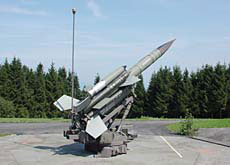Neutral Switzerland reveals its Cold War defences

While five out of six of Switzerland's former missile bases have been destroyed, one has been turned into a military museum.
The Menzingen base, positioned high on a hill above the town of Zug, acts as a showcase for military hardware, which was once primed to deal with the threat of the Cold War.
After serving as an active missile base from 1968 to 1999, the Menzingen site reopened as a museum earlier this year and it’s already welcomed more than 2,000 visitors.
Organisers hope that it will have clocked up more than 5,000 by the end of the year.
At first glance it’s hard to believe that 72 anti-aircraft missiles found their home among the rolling green hills and distant mountains.
But the grey concrete control tower on the horizon gives their location away, as does the wire fencing around the base.
Tours of the site are by appointment only so that guides can be arranged to show visitors around the firing units, radar centre, missile control bunker and storage areas.
Four missiles
The tour starts in the middle of a field where four missiles lie just metres from the path.
“The missiles all point in the same direction towards the east,” says Beat Wütrich, a former commander, who served at the base as part of his military service.
“At the time the main threat in our opinion came from the Soviet Union and the Warsaw pact states but the missiles could be turned around easily so we could launch in another direction.”
Cuban missile crisis
The Swiss government decided to buy 200 missiles from the British Aircraft Corporation in 1964, in the wake of the 1961 Cuban missile crisis
These were then distributed to its six bases in Zug, Zurich, Lucerne, Fribourg, Solothurn and Aarau.
Each missile was eight metres long, weighed two tons and could travel at two and a half times the speed of sound.
At the time the SFr380 million ($252 million) price tag was astronomical – with inflation it would be ten times as much today.
The missiles were also better than those in the British airforce’s own arsenal, which was one of the reasons why the arms purchase had to be kept such a secret.
“We bought the Mark 2 Bloodhound system, whereas the English had the Mark 1 system,” says Wütrich.
But every soldier who served on the base had to sign a secrecy document, declaring that they would not tell anyone – including their loved ones – about the site.
“It was hard at first but my wife stopped asking questions when she knew I couldn’t give her answers,” says Werner Bisseg, a former full-time training officer at the base.
But now times have changed: the base is common knowledge and its technology is far from state-of-the-art.
Radar Bunker
Inside the radar bunker it’s easy to see why the equipment is obsolete -countless circuits, metal tubes, cables and dials fill a large concrete room.
Wütrich believes that the radar room’s equipment could now fit on a couple of lap-tops.
In the missile control centre it’s even more antiquated. Maps of European airspace fill the walls and there’s a hotline phone on the main co-ordination desk, which officials in Bern would ring to give the command to fire the missiles – something that never happened.
Surrounded by such old equipment, which would be more at home in a Hollywood blockbuster, visitors tend to overlook the serious nature of protecting Switzerland against a Cold War threat.
“We knew that if there was a real threat, we would have a very important job,” say Wütrich, who used to man the missile control desk.
“Sometimes it was very difficult to think that by engaging the missile we could kill people.”
Neutrality
Switzerland has a long-cherished history of neutrality and during the Cold War its missiles were there to protect the nation, not to act as part of the western arsenal.
And even though no missiles were ever fired there were many occasions when the base was on high alert.
The most recent of these was in 1999, when Nato aircraft bombed Kosovo during the Balkans conflict.
In 1994 the Bloodhound system was replaced by the mobile Rapier missile system and while the old missiles are now on show for all to see. The Rapiers’ locations remain classified information.
swissinfo, Sally Mules
The Menzingen base is open all year round. It costs SFr250 for a group of 15 to visit on a designated open day and SFr350 on any other day. To find out more, as well as booking a visit, use the link www.mhsz.ch below.
All 200 Bloodhound missiles were decommissioned in 1999.
The mobile Rapier missile system replaced the Bloodhounds in 1994.
Six former missile bases in Switzerland spread across country.
Bloodhound system cost 380 million francs to set up in 1964.
No missiles were ever launched from Switzerland.
High above the city of Zug, a former Swiss missile base has been transformed into a military museum showcasing the country’s Cold War hardware and it’s already attracted thousands of visitors.

In compliance with the JTI standards
More: SWI swissinfo.ch certified by the Journalism Trust Initiative
You can find an overview of ongoing debates with our journalists here . Please join us!
If you want to start a conversation about a topic raised in this article or want to report factual errors, email us at english@swissinfo.ch.